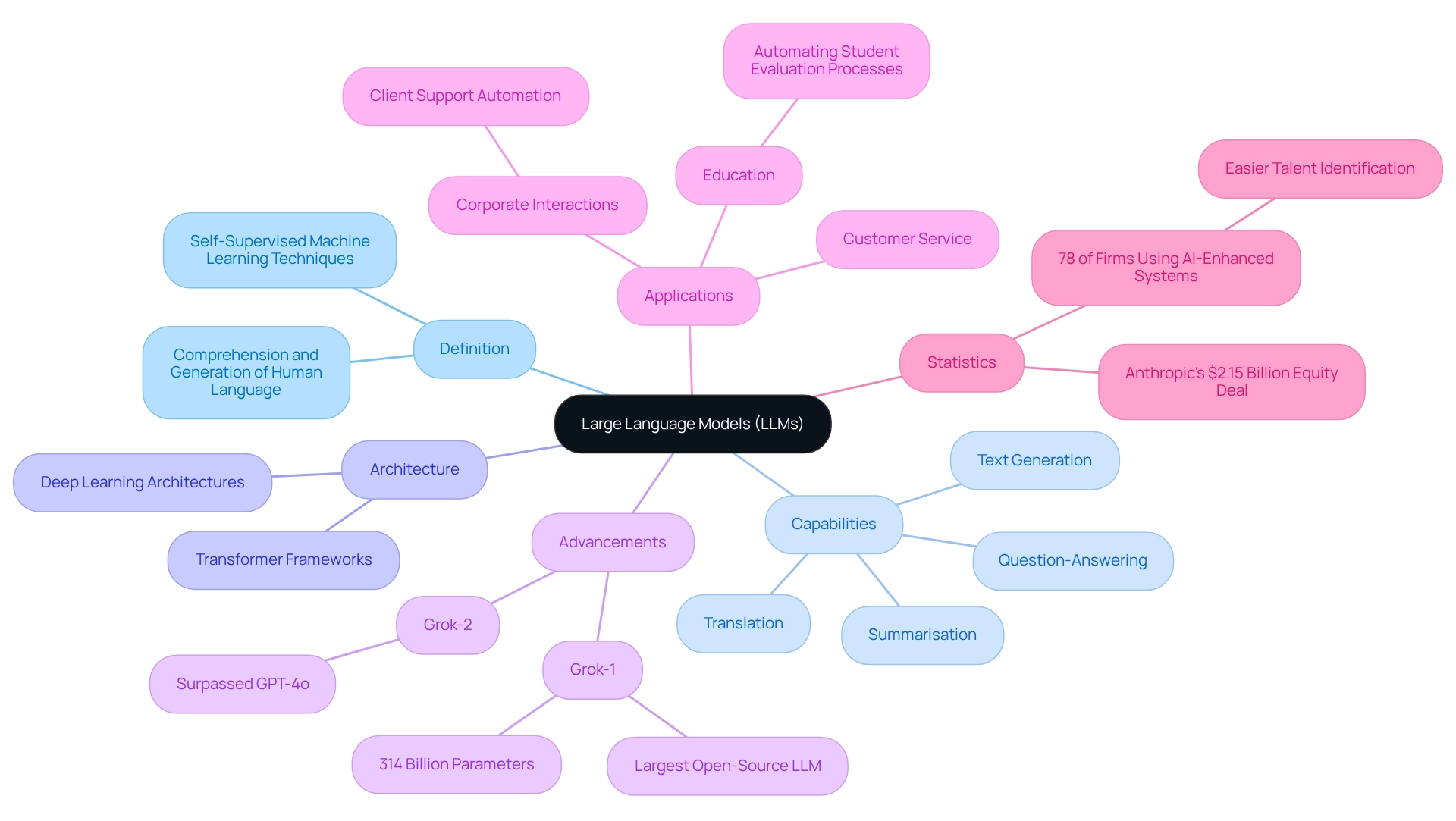
LLM Definition: Understanding Large Language Models and Their Impact
GeneralKey Highlights:
- Large Language Models (LLMs) are advanced AI systems designed to understand and generate human language using self-supervised machine learning on extensive text datasets.
- LLMs excel in various natural language processing tasks, including text generation, translation, summarization, and question-answering.
- The transformer architecture, introduced in 2017, revolutionised LLMs, enabling them to learn complex language representations, leading to models like BERT and GPT.
- Only 1.4% of U.S. businesses currently utilise natural language processing, indicating the early stage of NLP adoption.
- Key features of LLMs include adaptability, scalability, and the ability to perform sentiment analysis and translation, enhancing business communication.
- LLMs are transforming client support through automation, improving response times and customer satisfaction.
- In sales, LLMs analyse customer data to create personalised interaction strategies, increasing conversion rates.
- LLMs assist in content creation, ensuring consistency and quality while streamlining operational processes.
- Challenges in AI adoption for customer service include maintaining personalization and integration with existing systems.
Introduction
In the rapidly evolving landscape of artificial intelligence, Large Language Models (LLMs) emerge as a groundbreaking innovation, fundamentally reshaping how businesses communicate and engage with their audiences. These sophisticated models, powered by advanced deep learning techniques, excel in understanding and generating human language, while also automating and enhancing various communication processes. They revolutionise customer service through intelligent chatbots and craft personalised marketing strategies, proving to be invaluable assets across multiple sectors.
As organisations increasingly recognise the transformative potential of LLM technology, the journey of these models—from their humble beginnings in natural language processing to their current status as essential tools—unfolds. This evolution reveals a future brimming with possibilities for improved efficiency and engagement in business communication.
Define Large Language Models (LLMs)
The llm definition indicates that Large Language Models signify a monumental leap in artificial intelligence, meticulously designed to comprehend and generate human language. These models harness self-supervised machine learning techniques, trained on vast text datasets, enabling them to predict subsequent words in a sequence through contextual understanding. According to the llm definition, this predictive prowess empowers large language models to excel in a myriad of natural language processing tasks, including text generation, translation, summarisation, and question-answering.
Typically, these models are constructed on deep learning architectures, particularly transformer frameworks, which amplify their ability to produce coherent and contextually relevant text. Recent advancements have birthed remarkable models like Grok-1 and Grok-2, with Grok-1 standing out as the largest open-source LLM, exemplifying the llm definition with its impressive 314 billion parameters. Such developments underscore the growing potential of large language models, as indicated by the llm definition, to transform corporate interactions, particularly in client support, where they automate responses and elevate engagement.
Agentics capitalises on LLM technology to enhance its voice AI solutions, enabling organisations to optimise interactions and bolster stakeholder engagement. Statistics reveal that organisations employing AI-enhanced systems, which include the llm definition, witness substantial gains in operational efficiency. For instance, 78% of firms utilising AI-driven applicant tracking systems report heightened capabilities in identifying exceptional talent. As LLM technology continues to progress, the llm definition will encompass a broader range of applications across various sectors, including education and customer service, further cementing its role in contemporary business communication.

Trace the Evolution of LLMs
The evolution of large language models has its roots in the formative years of natural language processing during the 1950s and 1960s, marked by the inception of rudimentary rule-based systems and the pioneering chatbot, Eliza. A pivotal transformation occurred in the 1980s with the integration of statistical methods, which enabled models to analyse language patterns with greater efficacy.
However, the true breakthrough emerged with the introduction of neural networks, particularly the transformer architecture in 2017. This innovative framework empowered large language models to process vast datasets and learn complex language representations, leading to the creation of models such as BERT and GPT, which have set new performance benchmarks in NLP tasks.
Currently, a mere 1.4% of U.S. businesses are utilising or experimenting with natural language processing, underscoring the early stage of NLP adoption. As the NLP market evolves, it is anticipated to stabilise, concentrating on refining current technologies and exploring novel applications while tackling challenges such as bias and data privacy.
Importantly, Geoffrey Hinton has highlighted the role of large language models in medicine, underscoring their capacity for understanding and empathy, which exemplifies their practical applications. This evolution underscores the critical role of large language models, according to the llm definition, in shaping the future of AI-driven communication.
As Ray Kurzweil forecasts, artificial intelligence is projected to reach human-level capabilities by approximately 2029, signifying that large language models will be instrumental in this transformative journey.
Identify Key Features and Functions of LLMs
The llm definition emphasises that Large Language Models (LLMs) are distinguished by their remarkable ability to generate coherent and contextually relevant text, grasp linguistic nuances, and perform a diverse range of tasks such as summarisation, translation, and sentiment analysis. By leveraging advanced mechanisms like attention and self-attention, these models assess the significance of various words within a sentence, effectively preserving context throughout extensive texts. This capability proves particularly beneficial for companies like Agentics, which aim to enhance communication and automate processes through tailored voice AI solutions.
As we look ahead to 2025, the llm definition emphasises that key attributes of large language models include adaptability and scalability—crucial for organisations operating in ever-evolving environments. The Prometheus Evaluation Model serves as a prime example of an open-source LLM that democratises access to evaluation tools, empowering developers to utilise it independently of proprietary systems. This advancement not only enhances accessibility but also fosters innovation in LLM applications.
Moreover, businesses are increasingly harnessing large language models, which align with the llm definition, for sentiment analysis and translation, demonstrating their adaptability in real-world scenarios. Companies in customer support and marketing, including those utilising Agentics’ voice AI solutions, are leveraging LLMs to evaluate customer feedback and interpret interactions. This strategic use results in improved operational efficiency and heightened customer engagement. Expert insights underscore the importance of equitable access to large language models, emphasising that disparities in resources could hinder opportunities for certain enterprises. Ultimately, the llm definition illustrates how large language models represent a transformative force in corporate interactions, offering scalable solutions that evolve in response to changing demands.
Explore Applications of LLMs in Business Communication
The llm definition illustrates how Large Language Models (LLMs) are revolutionising business communication across various applications. In client support, they facilitate automation through chatbots that deliver immediate responses to enquiries, significantly enhancing client satisfaction. Organisations leveraging LLMs in service automation report improved response times and heightened engagement levels. In sales, these models analyse customer data to formulate personalised interaction strategies, leading to increased conversion rates. Notably, 96% of organisations recognise AI as a critical enabler for their operations, highlighting the escalating dependence on these technologies.
Furthermore, LLMs are indispensable in content creation, aiding companies in crafting marketing materials, reports, and social media posts. This ensures not only consistency and quality but also streamlines information exchange processes, ultimately reducing operational costs. A significant case study underscores the challenges organisations face in adopting AI for customer service, such as maintaining personalisation and integrating with existing systems. Addressing these challenges is crucial for successful AI implementation, as it directly influences consumer perceptions of AI interactions.
As companies increasingly integrate LLMs, the llm definition highlights the potential for improved communication efficiency and effectiveness, positioning these models as essential tools in contemporary business strategies.
Conclusion
The evolution of Large Language Models (LLMs) marks a significant transformation from basic natural language processing systems to advanced AI tools that are revolutionising business communication. By harnessing self-supervised machine learning and deep learning architectures, LLMs demonstrate exceptional proficiency in understanding and generating human language. This capability is invaluable across diverse applications, including customer service, content creation, and personalised marketing strategies.
As organisations increasingly integrate LLM technology, the benefits become unmistakable:
- enhanced operational efficiency
- improved customer engagement
- streamlined communication processes
The ability of LLMs to automate responses and analyse customer data not only boosts productivity but also enriches the overall customer experience. This shift represents a critical juncture for businesses, as they adopt AI-driven solutions to maintain competitiveness in a rapidly evolving landscape.
In conclusion, the potential of LLMs is extensive and still unfolding. As these models continue to progress, they promise to unveil new avenues for innovation and efficiency in business communication. The future is promising for those ready to leverage the power of LLMs, positioning them as essential assets for organisations striving to excel in the digital era. Embracing this technology today will set the stage for a more efficient, engaging, and effective communication landscape tomorrow.
Frequently Asked Questions
What are Large Language Models (LLMs)?
Large Language Models (LLMs) are advanced artificial intelligence systems designed to understand and generate human language. They utilise self-supervised machine learning techniques and are trained on extensive text datasets, allowing them to predict the next words in a sequence based on contextual understanding.
How do LLMs work?
LLMs work by employing deep learning architectures, particularly transformer frameworks, which enhance their ability to produce coherent and contextually relevant text. They excel in various natural language processing tasks such as text generation, translation, summarization, and question-answering.
What are some notable examples of LLMs?
Notable examples of LLMs include Grok-1 and Grok-2, with Grok-1 being recognised as the largest open-source LLM, featuring an impressive 314 billion parameters.
How are LLMs used in business?
LLMs are transforming business interactions, especially in client support, by automating responses and improving engagement. They are also being utilised to enhance voice AI solutions, helping organisations optimise interactions and boost stakeholder engagement.
What benefits do organisations experience by using LLM technology?
Organisations that implement AI-enhanced systems, including LLMs, often see significant improvements in operational efficiency. For example, 78% of firms using AI-driven applicant tracking systems report better capabilities in identifying exceptional talent.
What future applications can we expect from LLM technology?
As LLM technology continues to evolve, it is expected to expand its applications across various sectors, including education and customer service, further solidifying its importance in modern business communication.
Enjoyed this post? Share it with your network!
10 Best AI Sales Tools to Boost Your Team’s Performance

Discover the top 10 best AI sales tools to enhance team performance and drive revenue growth.
Mastering Test Call Numbers: A Step-by-Step Guide for Sales Directors

Elevate your communication with our guide on mastering test call numbers for sales success.
7 Ways Automated Outbound Calls Boost Sales Performance

Discover how automated outbound calls enhance sales performance and streamline communication.
